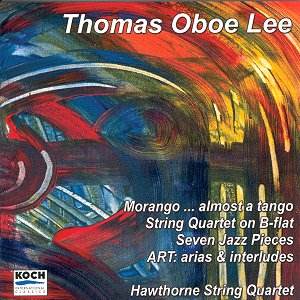Chinese-born Thomas Oboe Lee, who now teaches at Boston
College, spent several years in Brazil before settling in the States.
He studied with Gunther Schuller at the New England Conservatory
(1972-1976), with Betsy Jolas at Tanglewood (1976) and with Earl
Kim at Harvard University (1977-1981). Such varied background may
partly explain his cosmopolitan approach; for, unlike that of some
of his younger colleagues (Zhou Long, Bright Sheng, Chen Yi or Qigang
Chen), his music seems more directly rooted in American or Western
musical traditions than in Chinese musical past. That is anyway
the impression I got when listening to this release of some of his
works for string quartet. He admits the influence of many present-day
musical trends, including some popular ones such as jazz and tango;
but things are not really as simple as expected. In this respect
the first work in this disc aptly illustrates Lee’s musical making.
Morango...almost a tango (note the second part of
the title: almost) inevitably nods towards Latin America
and the popular tango rhythms. This lovely piece opens with a dreamy
ostinato played by the cello, clearly unrelated (at least
directly) to tango, whereas the tango itself is rather hinted at
than bluntly imitated. More remarkably still,. as the other pieces
here will also clearly demonstrate, the composer eschews any attempt
at pastiche or parody. Rather his music, at least, in the pieces
recorded here, pays sincere tribute to a number of musicians and
musical styles that have obviously meant much to Lee.
This is quite evident, too, in the Seven
Jazz Pieces which pay homage to Horace Silver, Carlos
Jobim, Bill Evans and Jaco Pastorius by alluding to their music
or playing style without slavishly mimicking it. The music may
sometimes obliquely quote from them (but I am no jazz expert).
What comes through quite clearly is the imagination and playful
invention of Lee’s affectionate homage. Characteristically enough,
though, the ‘homage movements’ are framed by a pensive, ‘prayerful’
slow Prelude and Postlude as well as including another reflective
Interlude.
The somewhat more recent ART: arias and
interludes is a substantial suite of five concise movements
alluding to characters of the Commedia dell’arte beginning
with a portrait of Pulcinella (a ‘mad polka’ depicting ‘a drunken
lout whose every gesture was obscene’ [Stravinsky’s words]) and
ending with Pantaloon’s Bolero, but also including a lament
(Pierrot’s Dream), a virtuosic Scherzo (Harlequin’s
Pantomime) and a frenetic, almost exhibitionist showpiece
(Colombine’s Delirium). Again, neither pastiche nor parody
in this superbly crafted music, although irony is not totally
absent from these vividly depicted character sketches.
The String Quartet on B-flat (again,
note the on rather than the more traditional in)
is on the whole a more serious work though it too has its share
of musical allusions to some superficially disparate musical modes.
There is a Funky Scherzo and a Lamentoso...mazurka-like
(sic), which say much about Lee’s dogmatically free approach to
musical form. I found this work marginally less compelling than
its companions here.
The Hawthorne String Quartet’s members (all members
of the Boston Symphony Orchestra) obviously enjoy the music and
play with communicative commitment that is refreshing and irresistible.
Lee’s superbly crafted, appealing music was quite
new to me; but I would now definitely want to hear more of it.
Recommended and well worth looking for.
Hubert Culot
